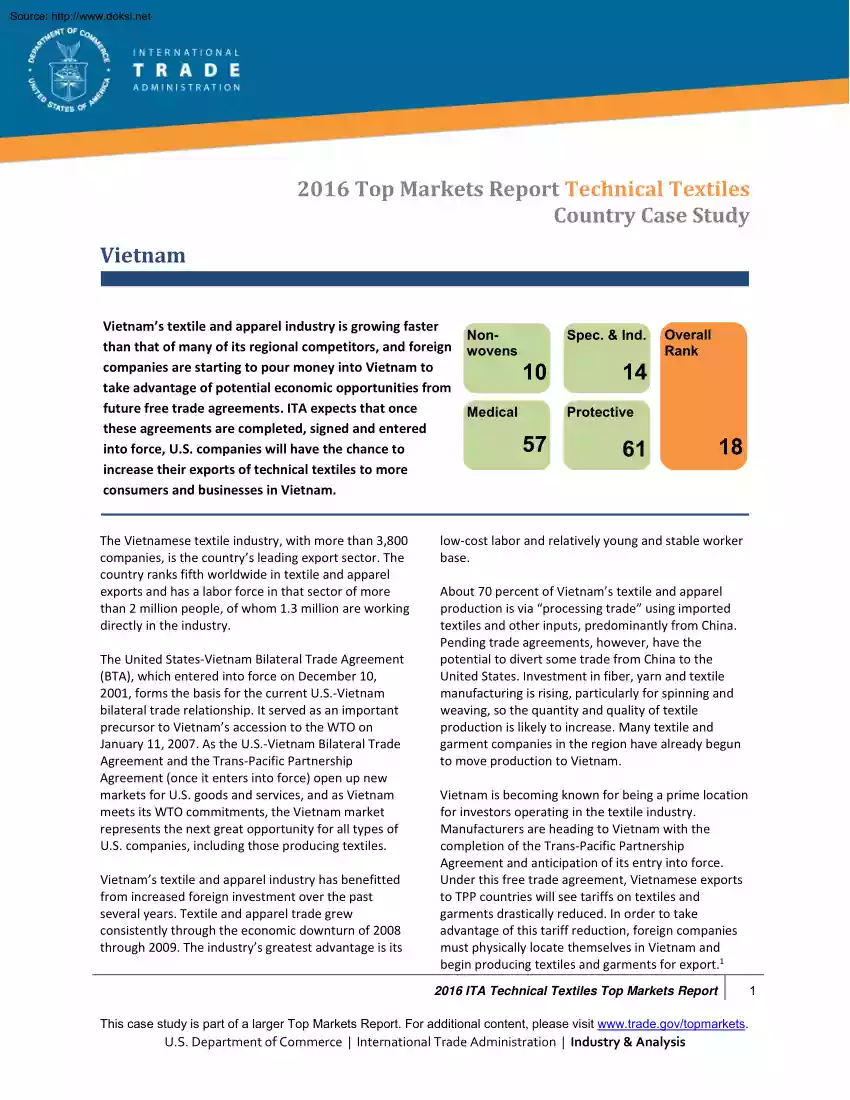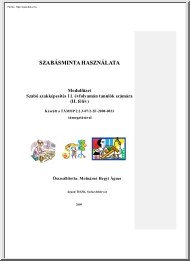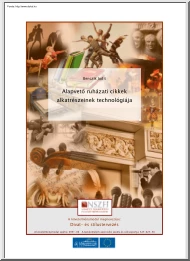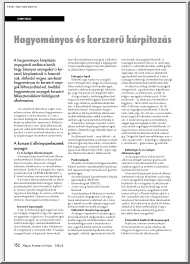Datasheet
Year, pagecount:2016, 3 page(s)
Language:English
Downloads:2
Uploaded:February 19, 2018
Size:692 KB
Institution:
-
Comments:
International Trade Administration
Attachment:-
Download in PDF:Please log in!
Comments
No comments yet. You can be the first!Content extract
Source: http://www.doksinet 2016 Top Markets Report Technical Textiles Country Case Study Vietnam Vietnam’s textile and apparel industry is growing faster than that of many of its regional competitors, and foreign companies are starting to pour money into Vietnam to take advantage of potential economic opportunities from future free trade agreements. ITA expects that once these agreements are completed, signed and entered into force, U.S companies will have the chance to increase their exports of technical textiles to more consumers and businesses in Vietnam. The Vietnamese textile industry, with more than 3,800 companies, is the country’s leading export sector. The country ranks fifth worldwide in textile and apparel exports and has a labor force in that sector of more than 2 million people, of whom 1.3 million are working directly in the industry. The United States‐Vietnam Bilateral Trade Agreement (BTA), which entered into force on December 10, 2001, forms the basis for the
current U.S‐Vietnam bilateral trade relationship. It served as an important precursor to Vietnam’s accession to the WTO on January 11, 2007. As the US‐Vietnam Bilateral Trade Agreement and the Trans‐Pacific Partnership Agreement (once it enters into force) open up new markets for U.S goods and services, and as Vietnam meets its WTO commitments, the Vietnam market represents the next great opportunity for all types of U.S companies, including those producing textiles Vietnam’s textile and apparel industry has benefitted from increased foreign investment over the past several years. Textile and apparel trade grew consistently through the economic downturn of 2008 through 2009. The industry’s greatest advantage is its Nonwovens Spec. & Ind 10 Medical Overall Rank 14 Protective 57 61 18 low‐cost labor and relatively young and stable worker base. About 70 percent of Vietnam’s textile and apparel production is via “processing trade” using imported textiles
and other inputs, predominantly from China. Pending trade agreements, however, have the potential to divert some trade from China to the United States. Investment in fiber, yarn and textile manufacturing is rising, particularly for spinning and weaving, so the quantity and quality of textile production is likely to increase. Many textile and garment companies in the region have already begun to move production to Vietnam. Vietnam is becoming known for being a prime location for investors operating in the textile industry. Manufacturers are heading to Vietnam with the completion of the Trans‐Pacific Partnership Agreement and anticipation of its entry into force. Under this free trade agreement, Vietnamese exports to TPP countries will see tariffs on textiles and garments drastically reduced. In order to take advantage of this tariff reduction, foreign companies must physically locate themselves in Vietnam and begin producing textiles and garments for export.1 2016 ITA Technical
Textiles Top Markets Report This case study is part of a larger Top Markets Report. For additional content, please visit wwwtradegov/topmarkets U.S Department of Commerce | International Trade Administration | Industry & Analysis 1 Source: http://www.doksinet Vietnam’s textile industry will depend on demand from the United States and the European Union, which account for 18 percent and 14 percent of Vietnam’s exports, respectively. This demand will purportedly contribute to export growth of 20 percent this year. Export businesses, especially foreign‐invested manufacturing firms, will provide a much needed boost to Vietnam’s growth.2 Overview of the Technical Textile Market Vietnam has a rapidly growing and vibrant textile industry, largely based on imported inputs. US exports of technical textiles to Vietnam grew by an impressive 539 percent to $46.9 million between 2008 and 2015. In 2008, U.S exports of technical textiles to Vietnam accounted for about 21 percent of
total U.S textile and apparel exports to Vietnam, and that number increased to 46 percent by 2015. Export growth has been especially fast for fabrics and textile mill products, particularly specialty and industrial fabrics. To take advantage of this growing trend and dependence of U.S inputs, Vietnam continues to import machinery to support its growing technical textile sector. Currently, Vietnam comprises a very small percentage of U.S technical textile exports, but this growth is encouraging for producers. US exports of niche products, such as specialty and industrial fabrics, increased markedly over the seven year period of 2008 to 2015 from $3.6 million to $223 million. U.S industry associations, such as the Industrial Fabrics Association International (IFAI), are very interested in the market potential in Vietnam. IFAI plans to increase textile niche product exports to Vietnam. As Vietnam moves up the production chain, up‐and‐coming manufacturing sectors, such as autos, marine
and hospitality sectors will also offer market potential for U.S technical textiles To support these new manufacturing sectors, Vietnam will need to expand markets, diversify product categories and designs and enhance product quality.3 Challenges and Barriers to Technical Textile Exports Doing business in Vietnam can be challenging. In 2008, Vietnam introduced an import licensing regime on a number of products, mostly consumer goods. On May 28, 2010, Vietnam’s Ministry of Industry and Trade published Circular 24, which extended the list of products for which licenses that were required, including textile and apparel products. This requires local importers to obtain an automatic import license (AIL) before shipments can be unloaded at a Vietnamese port. The license is apparently not, however, automatic, as reportedly products cannot move until the importer has the license in hand, a process that is supposed to take seven days but, according to industry in practice, often takes
longer. Many US companies have reported that delays in receiving AILs have resulted in decreased shipments into Vietnam and significant losses. Importers must wait until they have an original Bill of Lading (BL) before applying for the AIL, which limits their ability to apply for AILs early to avoid delays (a BL cannot be obtained until cargo has been loaded). Additionally, while Vietnam has reduced tariffs on many products in line with its WTO commitments, high tariffs on selected products remain. US industry has identified a range of products, including textile products where it sees significant potential of export growth if Vietnam’s tariffs could be reduced further. Investors in Vietnam also report that they often find poorly developed infrastructure, high start‐up costs, arcane land acquisition and transfer regulations and procedures, and a shortage of skilled personnel. Opportunities for U.S Companies Vietnam has made significant progress in eliminating nontariff barriers
(NTBs) under the 2001 United States‐Vietnam BTA and since Vietnam’s accession to the WTO. Additionally, Vietnam’s engagement and commitment to the TPP agreement will afford U.S textile producers preferential access to the Vietnamese market. This would most likely result in new business opportunities for U.S fiber, yarn and fabric producers. Vietnamese producers depend largely on fabric imported from China; however, with the entry into force of the TPP agreement, this trade could to shift to U.S producers 2016 ITA Technical Textiles Top Markets Report This case study is part of a larger Top Markets Report. For additional content, please visit wwwtradegov/topmarkets 2 Source: http://www.doksinet Figures from the Vietnam Textile and Apparel Association (Vitas) showed that 70 percent of more than 3,700 textile factories in the country make apparel; only 6 percent produce yarn, 17 percent make fabric, and 4 percent are dye houses. There is a huge void in textile production, and
as Vietnam’s technical textile industry continues to evolve, this will only increase opportunities for exports from the United States. Vietnam is a true emerging market, offering ground floor and growing opportunities for U.S exporters and investors Moreover, with plentiful competitively‐priced labor, Vietnam has a distinct cost advantage over other countries such as China. Vietnam also has developed supportive government policies, begun to implement major infrastructure projects and introduced incentives for foreign producers. All of this has the goal to attract foreign direct investment. Non‐wovens Vietnam has emerged as a hotbed of activity in non‐ woven products, as U.S manufacturers continue to invest ambitiously in the region. Vietnam is seizing this opportunity with an industry restructuring plan for the non‐wovens market over the next two years. This should result in attracting additional investment. percent of U.S technical textile exports to Vietnam Over the past
seven years, non‐woven exports to Vietnam from the United States have grown at annual rate of 38 percent. Specialty and Industrial Fabrics Vietnam has been expanding its reach into industrial fabrics and higher‐end textiles in recent years, including tire cord and coated fabrics. Overall, US exports of specialty and industrial fabrics have grown 30 percent annually since 2008, but in dollars, the U.S export totals are low compared to other competing countries. Protective Apparel Of the four technical textile sub sectors, protective apparel has seen the smallest growth and is the least significant. Vietnamese garment and textile companies have to meet U.S health and safety requirements for consumers, like flame retardant standards. Health safety is always of a top concern of consumer protection associations and the U.S government High standards and regulations on garment and textile raw materials protect consumers and may indirectly encourage manufacturers and exporters to invest in
modern, advanced production technologies to be certified. In 2015, U.S exporters saw significant growth in the non‐wovens sector, which accounted for roughly 48 1 Platzer, Michaela D. “US Textile Manufacturing and the Trans-Pacific Partnership Negotiations” Congressional Research Service August 28, 2014. 2 Platzer, Michaela D. “US Textile Manufacturing and the Trans-Pacific Partnership Negotiations” Congressional Research Service. August 28, 2014 3 Thinh, Hien “US Non-tariff Barriers to Vietnam Exports” Vietnam Business Forum. July 16, 2014 2016 ITA Technical Textiles Top Markets Report This case study is part of a larger Top Markets Report. For additional content, please visit wwwtradegov/topmarkets 3
current U.S‐Vietnam bilateral trade relationship. It served as an important precursor to Vietnam’s accession to the WTO on January 11, 2007. As the US‐Vietnam Bilateral Trade Agreement and the Trans‐Pacific Partnership Agreement (once it enters into force) open up new markets for U.S goods and services, and as Vietnam meets its WTO commitments, the Vietnam market represents the next great opportunity for all types of U.S companies, including those producing textiles Vietnam’s textile and apparel industry has benefitted from increased foreign investment over the past several years. Textile and apparel trade grew consistently through the economic downturn of 2008 through 2009. The industry’s greatest advantage is its Nonwovens Spec. & Ind 10 Medical Overall Rank 14 Protective 57 61 18 low‐cost labor and relatively young and stable worker base. About 70 percent of Vietnam’s textile and apparel production is via “processing trade” using imported textiles
and other inputs, predominantly from China. Pending trade agreements, however, have the potential to divert some trade from China to the United States. Investment in fiber, yarn and textile manufacturing is rising, particularly for spinning and weaving, so the quantity and quality of textile production is likely to increase. Many textile and garment companies in the region have already begun to move production to Vietnam. Vietnam is becoming known for being a prime location for investors operating in the textile industry. Manufacturers are heading to Vietnam with the completion of the Trans‐Pacific Partnership Agreement and anticipation of its entry into force. Under this free trade agreement, Vietnamese exports to TPP countries will see tariffs on textiles and garments drastically reduced. In order to take advantage of this tariff reduction, foreign companies must physically locate themselves in Vietnam and begin producing textiles and garments for export.1 2016 ITA Technical
Textiles Top Markets Report This case study is part of a larger Top Markets Report. For additional content, please visit wwwtradegov/topmarkets U.S Department of Commerce | International Trade Administration | Industry & Analysis 1 Source: http://www.doksinet Vietnam’s textile industry will depend on demand from the United States and the European Union, which account for 18 percent and 14 percent of Vietnam’s exports, respectively. This demand will purportedly contribute to export growth of 20 percent this year. Export businesses, especially foreign‐invested manufacturing firms, will provide a much needed boost to Vietnam’s growth.2 Overview of the Technical Textile Market Vietnam has a rapidly growing and vibrant textile industry, largely based on imported inputs. US exports of technical textiles to Vietnam grew by an impressive 539 percent to $46.9 million between 2008 and 2015. In 2008, U.S exports of technical textiles to Vietnam accounted for about 21 percent of
total U.S textile and apparel exports to Vietnam, and that number increased to 46 percent by 2015. Export growth has been especially fast for fabrics and textile mill products, particularly specialty and industrial fabrics. To take advantage of this growing trend and dependence of U.S inputs, Vietnam continues to import machinery to support its growing technical textile sector. Currently, Vietnam comprises a very small percentage of U.S technical textile exports, but this growth is encouraging for producers. US exports of niche products, such as specialty and industrial fabrics, increased markedly over the seven year period of 2008 to 2015 from $3.6 million to $223 million. U.S industry associations, such as the Industrial Fabrics Association International (IFAI), are very interested in the market potential in Vietnam. IFAI plans to increase textile niche product exports to Vietnam. As Vietnam moves up the production chain, up‐and‐coming manufacturing sectors, such as autos, marine
and hospitality sectors will also offer market potential for U.S technical textiles To support these new manufacturing sectors, Vietnam will need to expand markets, diversify product categories and designs and enhance product quality.3 Challenges and Barriers to Technical Textile Exports Doing business in Vietnam can be challenging. In 2008, Vietnam introduced an import licensing regime on a number of products, mostly consumer goods. On May 28, 2010, Vietnam’s Ministry of Industry and Trade published Circular 24, which extended the list of products for which licenses that were required, including textile and apparel products. This requires local importers to obtain an automatic import license (AIL) before shipments can be unloaded at a Vietnamese port. The license is apparently not, however, automatic, as reportedly products cannot move until the importer has the license in hand, a process that is supposed to take seven days but, according to industry in practice, often takes
longer. Many US companies have reported that delays in receiving AILs have resulted in decreased shipments into Vietnam and significant losses. Importers must wait until they have an original Bill of Lading (BL) before applying for the AIL, which limits their ability to apply for AILs early to avoid delays (a BL cannot be obtained until cargo has been loaded). Additionally, while Vietnam has reduced tariffs on many products in line with its WTO commitments, high tariffs on selected products remain. US industry has identified a range of products, including textile products where it sees significant potential of export growth if Vietnam’s tariffs could be reduced further. Investors in Vietnam also report that they often find poorly developed infrastructure, high start‐up costs, arcane land acquisition and transfer regulations and procedures, and a shortage of skilled personnel. Opportunities for U.S Companies Vietnam has made significant progress in eliminating nontariff barriers
(NTBs) under the 2001 United States‐Vietnam BTA and since Vietnam’s accession to the WTO. Additionally, Vietnam’s engagement and commitment to the TPP agreement will afford U.S textile producers preferential access to the Vietnamese market. This would most likely result in new business opportunities for U.S fiber, yarn and fabric producers. Vietnamese producers depend largely on fabric imported from China; however, with the entry into force of the TPP agreement, this trade could to shift to U.S producers 2016 ITA Technical Textiles Top Markets Report This case study is part of a larger Top Markets Report. For additional content, please visit wwwtradegov/topmarkets 2 Source: http://www.doksinet Figures from the Vietnam Textile and Apparel Association (Vitas) showed that 70 percent of more than 3,700 textile factories in the country make apparel; only 6 percent produce yarn, 17 percent make fabric, and 4 percent are dye houses. There is a huge void in textile production, and
as Vietnam’s technical textile industry continues to evolve, this will only increase opportunities for exports from the United States. Vietnam is a true emerging market, offering ground floor and growing opportunities for U.S exporters and investors Moreover, with plentiful competitively‐priced labor, Vietnam has a distinct cost advantage over other countries such as China. Vietnam also has developed supportive government policies, begun to implement major infrastructure projects and introduced incentives for foreign producers. All of this has the goal to attract foreign direct investment. Non‐wovens Vietnam has emerged as a hotbed of activity in non‐ woven products, as U.S manufacturers continue to invest ambitiously in the region. Vietnam is seizing this opportunity with an industry restructuring plan for the non‐wovens market over the next two years. This should result in attracting additional investment. percent of U.S technical textile exports to Vietnam Over the past
seven years, non‐woven exports to Vietnam from the United States have grown at annual rate of 38 percent. Specialty and Industrial Fabrics Vietnam has been expanding its reach into industrial fabrics and higher‐end textiles in recent years, including tire cord and coated fabrics. Overall, US exports of specialty and industrial fabrics have grown 30 percent annually since 2008, but in dollars, the U.S export totals are low compared to other competing countries. Protective Apparel Of the four technical textile sub sectors, protective apparel has seen the smallest growth and is the least significant. Vietnamese garment and textile companies have to meet U.S health and safety requirements for consumers, like flame retardant standards. Health safety is always of a top concern of consumer protection associations and the U.S government High standards and regulations on garment and textile raw materials protect consumers and may indirectly encourage manufacturers and exporters to invest in
modern, advanced production technologies to be certified. In 2015, U.S exporters saw significant growth in the non‐wovens sector, which accounted for roughly 48 1 Platzer, Michaela D. “US Textile Manufacturing and the Trans-Pacific Partnership Negotiations” Congressional Research Service August 28, 2014. 2 Platzer, Michaela D. “US Textile Manufacturing and the Trans-Pacific Partnership Negotiations” Congressional Research Service. August 28, 2014 3 Thinh, Hien “US Non-tariff Barriers to Vietnam Exports” Vietnam Business Forum. July 16, 2014 2016 ITA Technical Textiles Top Markets Report This case study is part of a larger Top Markets Report. For additional content, please visit wwwtradegov/topmarkets 3





 Just like you draw up a plan when you’re going to war, building a house, or even going on vacation, you need to draw up a plan for your business. This tutorial will help you to clearly see where you are and make it possible to understand where you’re going.
Just like you draw up a plan when you’re going to war, building a house, or even going on vacation, you need to draw up a plan for your business. This tutorial will help you to clearly see where you are and make it possible to understand where you’re going.